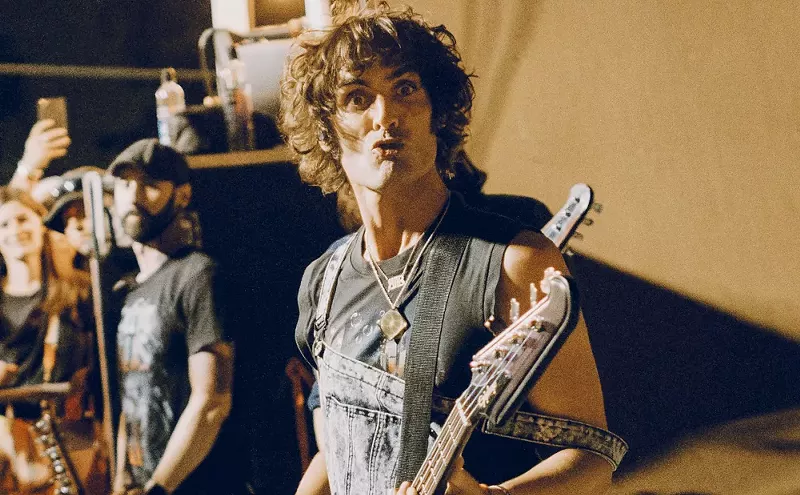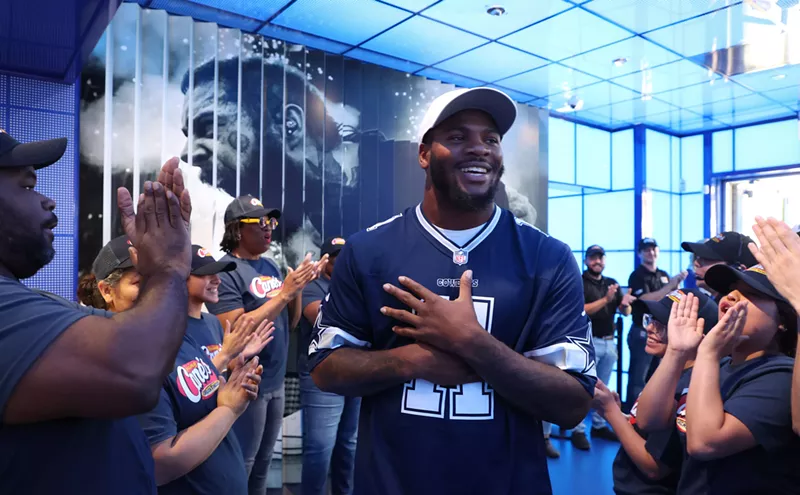As a kid in Brooklyn, Darren Aronofsky used to steal into Manhattan, taking the D train across the East River to sneak into movies such as A Clockwork Orange and Eraserhead. These were R-rated, and he was still 15 or 16. "They were films," he says, smiling, "you weren't supposed to see." A decade and a half later, now established as a promising writer-director, he makes movies for those same restless young people.
As such, his films--on view, as is the director himself, during this week's SMU Student Film Festival--are unlikely to snag the audience pining for more Jane Austen remakes. His high-impact 1998 debut, Pi, was a Sundance hit that managed to create dramatic heat around irrational numbers, personal computers and the Kabbalah--it was, so the buzz went, a difficult movie about a genius, created by a difficult genius. A kind of Matrix for would-be intellectuals, the no-budget film was a hit with young cineasts after a guerrilla marketing campaign in which New York lampposts and sidewalks were covered with Pi stickers. Some fans of the movie imagined its creator to be as neurotic and brilliant as Pi's manic hero, Max Cohen: Rumors floated that here was a very smart, very cocky young man, a wayward genius so arrogant that people left meetings in tears.
Now 31, the Harvard-educated Aronofsky has generated a sizable reputation for both egomania and divine inspiration. With the release last year of Requiem for a Dream, he's beginning to generate a reputation for cinematic excruciation as well. (At the same time, he's gotten the ultimate mainstream nod: Warner Bros. has chosen him to direct the next film of the wilting Batman franchise.) Adapted from the 1978 novel by cult writer Hubert Selby Jr., Requiem traces the crack-up of four addicts--Harry Goldfarb (Jared Leto), his widowed mother, Sara (Ellen Burstyn), his homeboy and his girlfriend. The three young uns score a very potent strain of heroin while Sara obsesses over TV and diet pills.
While Requiem is descended from postwar "social-problem" films such as The Lost Weekend (1945) and Asphalt Jungle (1950) and strung-out New York melodramas like The Panic in Needle Park (1971), the movie takes these grim genres and energizes them with a visual style akin to Godard and MTV. The movie makes promiscuous use of split screens, fish-eye lenses, rapid cutting, sudden tempo shifts and mad montage--including a sequence with boiling junk and a dilating eyeball that accompanies each scene of shooting up. As with Pi's kinetic techno soundtrack, hip-hop and electronica drive the film. Although it lacks the stark visual signatures of Pi--marked by the bold contrasts of black-and-white reversal film stock--Requiem shows maturity in both its cinematography and its performances (e.g., Burstyn was nominated for an Academy Award for her supporting role).
Requiem received a five-minute standing ovation at its Cannes Film Festival debut. Although reviews were mixed--the Dallas Observer named it a top-10 film of 2000--The New York Times hit on one of Requiem's most curious qualities: Aronofsky "is in as much of a junky delirium as his characters. It's obvious to say that moviemaking is his high, but it's also undeniable."
"There's definitely an audience for punk movies," Aronofsky says. "An audience that enjoys its movies black, with no cream or sugar. They want it straight up."
Aronofsky describes his Brooklyn neighborhood, Manhattan Beach, as looking like the row houses in the credit sequence of All in the Family. The director grew up the son of two teachers in this Jewish and Italian enclave next to Brighton Beach and two miles from Coney Island. As a kid, he had no special interest in making movies and was drawn instead to black-and-white photography and, by high school, to writing "angst-filled teen-age prose." He was neither a cinema nut nor a bookworm. But other influences developed. A friend's older brother introduced him to The Twilight Zone when he was 10 or 11, which played after midnight. "Every single Wednesday," he says, "I'd set the alarm to wake me up at 12:15 and sneak down to the TV and watch it without my parents knowing." While other kids in school did biographical reports on Thomas Jefferson and Abe Lincoln, he put one together on Rod Serling.
Another early hero was Bill Cosby, whose 1960s comedy albums Aronofsky listened to incessantly through his junior high years. "His sense of story structure and the way he set up jokes was a very big influence on me. I used to memorize and repeat his monologues to friends." Cosby's wry tales sketched an urban world similar to Aronofsky's. "He wasn't the guy who told jokes--he'd tell stories that had the payoff of a big joke at the end."
His early influences came from TV and old records, he says, partly because Brooklyn didn't have an art house. He went to Spielberg and Lucas films and relied on humbler venues. "I think one year, 1978, it was 'The 78 Cent Theatre'; in 1979, it was 'The 79 Cent Theatre.' It was a second-run, double-bill theater. But if you think about all the films in the '70s, we were really blessed, because they were basically art films. I remember going to see The First Great Train Robbery and The Brink's Job as a double bill--and both those films, if they were released today, would be considered independent art films."
High school, at the public Edward R. Murrow High, taught him mostly how to cheat and cut class. The only book he remembers reading all the way through was Dostoyevsky's Crime and Punishment. But during senior year, he stumbled on something that made a lasting impact: Aronofsky and a friend went to Brooklyn's only mall, King's Plaza, to see a Hollywood movie he now can't recall. But they got there late and couldn't get in because the film had sold out. The two guys were determined to see something. "I saw a poster with a goofy guy with a Brooklyn hat, went in, and it turned out to be She's Gotta Have It. And I remember being just blown away. It spoke to me partly because I was from Brooklyn, and I really related to the hip-hop culture, but also the whole aesthetic of it was really refreshing."
His interest in film sparked, he still headed to Harvard in 1987. Although his first two years of college were "mostly about sex and drugs," there was no stopping him once he discovered moviemaking. "It was the first thing that kept me awake at night. I'd run out of my girlfriend's bed in my underwear to the editing room and not come back until I'd finished a cut."
A year after graduating from Harvard, Aronofsky headed to the AFI Conservatory, the Hollywood-based film school. During his time at AFI, he also got some important advice from one of his professors--Stuart Rosenberg, the director of Cool Hand Luke and The Pope of Greenwich Village, who told Aronofsky: "Make 'em laugh, make 'em cry, or scare the shit out of 'em." (Advice, it seems, that he's taken to heart.)
As good a stretch as L.A. was, Aronofsky knew he couldn't stay. He returned to New York in 1995 and began putting together the plan for Pi. He drew from friends (lead Sean Gullette was a Harvard classmate) and family (his mom made and served the food to cast and crew). And Aronofsky hit up virtually everybody he knew to help finance the picture, getting "investments" of $100 at a time and promising to pay them back, with interest, if the film made money. With a budget of only $60,000, it did.
In an interview, the director comes across as driven and serious about filmmaking but not the rude or self-absorbed guy we've heard about. Looking back at the shoot, Burstyn talks about how "considerate" he was. Where's Aronofsky's legendary arrogance? Except for the occasional slip ("I hope you're doing a big piece on me, baby! Not that I don't love tawking to you, my friend!"), he seems like a typical hardworking, middle-class kid who toiled his way into the Ivy League. Let him roam, and he talks about childhood friends he "met on tricycles" and about "what a gift, what a present" it is to work with talented actors--as if he were rehearsing for an appearance on Entertainment Tonight.
Requiem received an NC-17 rating upon its release when Aronofsky refused to recut his film. The rating was designed by the MPAA in 1990 to serve as a nonporn alternative to the X (an unofficial rating now, as then). This way, the thinking went, serious films aimed at adults could avoid the stigma of movies for lonely men in raincoats. But NC-17 films quickly acquired their own stigma: In the last few years, the rating has gone to trash such as Showgirls while more "respectable" films--Stanley Kubrick's Eyes Wide Shut and Mary Harron's American Psycho--have been recut to fit the restrictions of an R movie.
Of course, if the MPAA was really doing its job, Requiem would never have drifted into its crosshairs. While the film is troubling, it's not violent, and what little brutality there is arises as a kind of punishment for drug use. The film does not posit shooting up as a smart career move. If anything, Requiem is so cruel a cautionary tale that it risks feeling sternly moralistic.
With Requiem, the MPAA was almost certainly responding to the final sequence--three minutes of grueling climax in which the characters are cast into private hells. The real problem isn't that the sequence is excessively violent or sexual--there's just a touch of each, and most of the action is implied--but that it's excessive moviemaking. Things happen too fast and too hard. One character ends up "performing" in front of an audience of malevolent yuppies, but her earlier arrival at a john's door--awkward, scared, still a little demure--made a far more eloquent statement of her decline than this appearance before a tribe of overgrown frat boys.
Aronofsky points out that scenes like this happen in America every day. "A lot of people who haven't been to bachelor parties or fraternity parties don't realize that this is happening behind closed doors every day in America. That scene is taken from something I witnessed."
Clearly, he wasn't trying for subtlety in that final scene. "This is a film for people who grew up on eight hours of TV, and five hours of Internet, a day. We're a generation overloaded by sound and images, and to reach audiences on that level, you basically have to take them somewhere super intense. And it was always meant that that three-minute climax was going to be a violent barrage on the audience--we wanted to bombard them. I wanted to make a roller coaster ride. One that smashed into a brick wall. At the fastest speed the film gets to, just smash into a brick wall." His voice lightens. "For me, I find that a lot of fun. There are people out there who like that type of movie. But if you want to see a film that's right down the middle of the road, please, please don't come see Requiem for a Dream."
John Pierson, indie film guru and Split Screen host, points out that the major indie auteurs of the late '90s--Neil LaBute, Kevin Smith and Todd Solondz--are writers first and visual artists second. Few current left-of-the-dial filmmakers, he says, have crafted a distinct visual style to match the verve of earlier indie gods such as Spike Lee, Jim Jarmusch and the Coen brothers. "There's just a handful on the visual side," he says. "Darren is one, and Todd Haynes is the other. And then you start scraping." While Pierson would like to see Aronofsky apply himself to a more traditional narrative for his next film or two, the young director's visual flair, he says, makes him a significant talent. "Darren is a real breath of fresh air."
Fresh or not, neither Aronofsky nor anyone at Warner Bros. seemed much interested in speaking about the director's helming of the Batman franchise. As reported by Daily Variety last month and rumored on the Internet since at least February, Aronofsky will both direct and work with comics artist Frank Miller to develop the screenplay for Batman: Year One, based on a noirish, 1987 comic-book series Miller wrote for DC Comics. Aronofsky seems like a left-field choice for the project, which will look at Bruce Wayne's initial year as the caped crusader. But it's not hard to figure out why Warner would look for fresh blood: Despite a good start with Tim Burton's first two films, Batman has gotten very lost under Joel Schumacher's stewardship. (Even gay men disowned '97's homoerotic Batman and Robin.) Picking Aronofsky, who's known for doing things his own way, suggests that the studio recognizes the need for serious surgery on its dying monster.
Aronofsky admits that he only got into comics seriously in the last half of college, when a friend turned him on to stuff like The Watchmen and The Dark Knight Returns, the latter written and illustrated by Miller. "He introduced psychological realism to comic-book characters," says Aronofsky. "What does it take for a real man to put on tights and fight crime?"
During the next few years, Aronofsky will be shooting Batman as well as a science-fiction script he's been writing since the beginning of the year. (Brad Pitt is rumored to star.) His tastes and ambitions send complicated signals. Will he follow the Brian DePalma model, beginning his career with smart, personal films and then drifting into indifference, or the trajectory of a Stanley Kubrick--establishing a signature style that's undiminished in studio settings? At this stage, Aronofksy resembles Tim Burton, the oddball director chosen for Batman on the evidence of the eccentric Beetlejuice--back when a Batman revival was a cool new idea and not a musty corporate warhorse.
"I hope I'm still working in 20 years," Aronofsky says. "I'd like to do a wide range of films--I'd like to do a musical, I'd like to do a western, I'd like to do a heist movie." He's interested, he says, in films big and small, mainstream and arty. "I have a taste for both of 'em. If I could work in both worlds, I'd be really happy."








